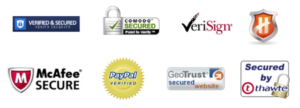It is no secret that counterfeit goods have leaked into e-commerce marketplaces in large numbers.
According to the International Chamber of Commerce, the global economic value of counterfeiting and piracy could reach $2.3 trillion USD by 2022. For a consumer, a counterfeit product might seem like an
innocent good deal, but real harm is being done to your company when the consumer buys counterfeit products.
Recently, the European Consumer Centres Network (ECC-Net) provided some handy tips for consumers
to protect themselves from counterfeit goods when shopping online. The ECC-Net’s report, The impact of counterfeiting on online consumer rights in Europe, highlights the alarming trends of counterfeit goods proliferating e-commerce marketplaces like Amazon or eBay.
The report highlights the adverse impacts counterfeit goods can have on both consumers and retailers,
including some very serious health, safety, and environmental implications. What’s more, the report
highlights how the sale of counterfeit goods online is closely linked to organized crime.
As highlighted in a previous GreyScout blog, counterfeit goods pose a great threat to a brand’s reputation. As a trusted e-commerce retailer, you have spent countless hours and resources to establish your brand and its products as reputable. Brands now need to defend themselves and protect their customers by having effective tools and systems in place to educate, guide, and protect consumers from the criminal underworld lurking on e-commerce marketplaces.
The ECC-Net provides some useful tips on how consumers can avoid buying these fake products on the
internet.
Here are some ideas from the report that e-commerce brands can implement to protect both
themselves and their shoppers:
Localize Yourself as a Seller
The ECC-Net report advises consumers to perform due diligence before placing an order with an e-
commerce retailer to ensure that they are dealing with a reputable company. E-commerce retailers
should ensure that their company information, including physical location, contact details, and other
pertinent information is easily accessible on their brand’s website to aid in consumer research.
Get Yourself a “Trust Mark”
The display of a “trust mark” – any third-party mark, logo, picture, or symbol that is presented to dispel
consumers’ concerns about internet security and privacy – can be a valuable tool to give consumers
peace of mind while shopping online. Examples of trust marks include the Better Business Bureau or a
Verisign seal.
Consumers continue to look for some level of security when shopping online and will not purchase from
websites that they do not consider to be trustworthy. A “trust mark” could be the final push a customer
needs to hit the check-out button with the confidence they are dealing with a reputable brand.
According to their own customer case studies, Verisign claims a 24 per cent increase in transactions
when the VeriSign seal was displayed on a merchant’s website.
Promote Consumer Rights
Your brand’s website should also have clear and correct information on its website about consumer
rights. The absence of such information on your website could raise some red flags for astute
consumers.
E-commerce retailers in the EU are obligated to display this information on their website, including
withdrawal rights or the existence of a statutory guarantee of at least two years. Online sellers
established within the EU should provide a link to the European platform for online alternative dispute resolution on their website.
Offer Only Secure Payment Methods
In their report, the ECC-Net offers “3 gold principles” for consumers to pay for goods online: only shop with vendors who have a secured payment page with an SLL certified “https” address, pay by credit card when available, and avoid money transfers. Brands should ensure that their accepted payment methods are in line with these principles to ensure their consumers know they’re being protected.
Use Brand Protection Solutions
Counterfeiting is a massive, trillion-dollar industry. As highlighted in this GreyScout article, however, counterfeiting and unauthorized 3P sellers on eCommerce marketplaces are just some of the many threats to a brand’s reputation that exists in the e-commerce sector. Hence, using a brand protection Solution to detect, verify and enforce eCommerce marketplace counterfeit listings at scale is the need of an hour.
The Bottom Line
The impacts of counterfeit goods on a brand’s reputation and revenue loss can be devastating. Brands
have a lot to lose by having their products fall into the hands of counterfeiters.
Peddlers of fraudulent products are becoming savvier, utilizing minimal equipment and materials to
produce some very convincing fakes, making it increasingly difficult for consumers to separate the
authentic from the frauds.
As a trusted e-commerce brand, you have a responsibility to both your own company and the e-commerce industry as a whole to protect the vulnerable consumer through simple measures like the
ones above.

